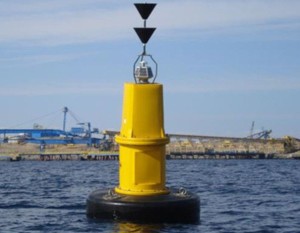
By Captain Richard Madden –
There are new buoys – and is some cases virtual buoys – coming to a U.S. port near you. First seen in the port of Mombasa, Kenya almost two years ago, AIS-assisted buoys (Real AIS ATON) – physical buoys with an AIS transmitter installed – will be rolled out in select areas on an experimental basis by the U.S. Coast Guard. These will be accompanied by both Synthetic AIS ATON – physical buoys overlaid with an AIS signal generated by a shoreside base station and Virtual AIS ATON – truly virtual buoys with no physical presence, which would be visible on an appropriately outfitted ECDIS, radar or computer.
U.S. Coast Guard to Test Automatic Identification System (AIS) Aids to Navigation (ATON)
Mariners first noted Real AIS ATON in the approaches to Mombasa, Kenya during routine transits. The addition of the AIS transmitters – which we do not believe was announced through NAVTEX or chart updates – have allowed these buoys to stand out more when viewed on the ECDIS, while still allowing visual use. The recent announcement by the U.S. Coast Guard highlights the chart symbols that will be in use. It is of note that these symbols are not yet in use on the U.K. Admiralty charts for the approaches to Mombasa (please see linked chart).
KPA – Mombasa – High Performance Navigation Aids Installed
As noted, in real-life applications, Real AIS ATON have proven to be beneficial. As with all methods of navigation, redundancy is extremely important, therefore coupling the physical ATON with the virtual ATON is a great combination. The introduction of the Virtual AIS ATON is a little more troubling however.
Research by Trend Micro Inc., an internet security company based out of Tokyo as announced by gCaptain has revealed some serious security issues with the AIS system. Being that AIS signals lack any form of encryption or authentication, they are vulnerable to hacking by outside forces. This has been demonstrated repeatedly by Trend Micro – including the spelling of the classic hacker tag “PWNED” with a vessel’s AIS track.
gCaptain – Researchers Discover Serious Security Vulnerabilities to AIS Data
Advances in aids to navigation are welcome – anything that can make the operation of vessel’s safer is great. However, it can be hoped that we don’t hang our hat – or the safety of vessels – entirely on the AIS system. Yet.
Captain Richard Madden is a maritime consultant and SUNY Maritime graduate with over 20 years of industry experience. He holds a USCG Unlimited Master’s license and has sailed on government vessels, offshore towing vessels, tankers, container ships, coastal towing and general cargo vessels.

 Join The Club
Join The Club











